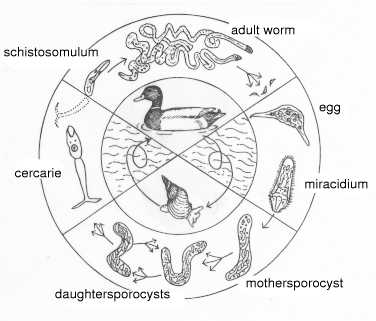
Lifecycle of Trichobilharzia ocellata

Lifecycle of Trichobilharzia ocellata |
Cercarial dermatitis of humans
("swimmer's itch", "Badedermatitis", "Weiherhippel") increased its prevalence in the past few years all over the northern
hemisphere, and in many recreational lakes bathing had to be prohibited. The main agent of cercarial dermatitis in Europe is the trematode worm parasite of ducks,
Trichobilharzia ocellata. The duck and the human accidental hosts are actively invaded by the water-living cercariae of the parasites, which emerge from
the aquatic snail Lymnaea stagnalis. Whereas the cercariae grow in the duck host to adult worms, they are unable to develop in the human host. But in the
human skin the penetrated larvae cause erythema and urticaria of the invaded area, and intense itching may last several days up to 3 weeks. The snail is invaded
by miracidia, which emerge from eggs, passed in feces of infected ducks. We maintain the life cycle of T. ocellata in the laboratory using ducks as final
hosts and the snail Lymnaea stagnalis as its intermediate host. We have analysed how the cercariae find and recognize their host's skin. In at least 5
host-identification phases, the parasites respond with high sensitivity and specificity to chemical host skin cues such as ceramides, cholesterol and defined fatty
acids, but also to temperature gradients, water currents and shadow stimuli. As they respond to defined free fatty acids with penetration behavior and transformation
of their body wall, like Schistosoma-cercariae, they might be controlled with the same methods as proposed for schistosome
cercariae. We have also studied the migration of radiolabelled larvae in the duck and the abnormal murine host. In the mouse host the parasites reached lungs,
liver and intestine, and it may be suggested, that this occurs also in humans. We presently also investigate, how the miracidia
find and recognize their snail intermediate hosts. Main cues for the chemo-orientation are host-species specific macromolecular glycoconjugates.
|
|
Wilfried Haas, Tina Loy, Cynthia Wulff, Jan Hertel, Alexander Holweg